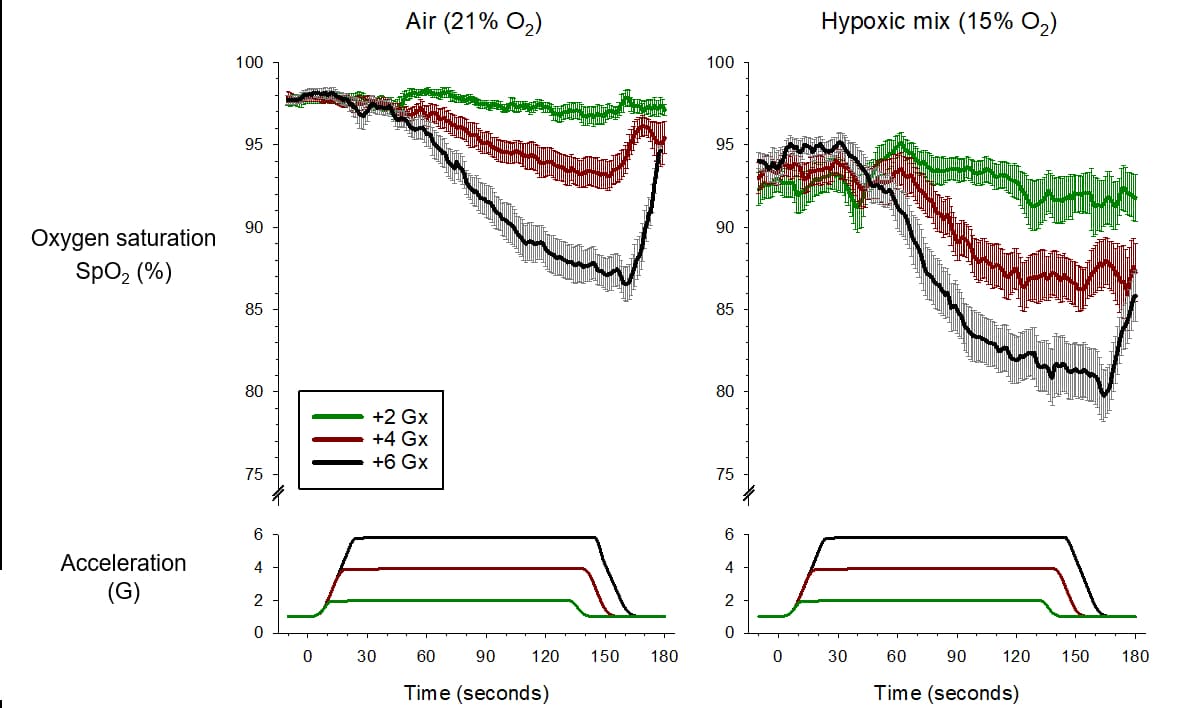Introduction: Commercial suborbital space flight will soon become a reality with members of the public potentially being exposed to acceleration loads of up to +6 Gx1. The clinical and physiological implications of this are poorly understood2. The lung is highly gravity-dependent, and gas exchange and respiratory mechanics may be impaired, both of which may have clinical implications. We therefore conducted a centrifuge study to investigate how the lungs and pulmonary mechanics are affected by 2 min exposures to acceleration of up to +6 Gx. Method: The study was conducted on a human centrifuge with all procedures approved by King’s College London and QinetiQ research ethics committees. Eleven healthy participants (3 female) were exposed to 2, 4 and 6 Gx twice, once breathing air and once breathing 15% oxygen to simulate an altitude of 8,000 ft. Regional distribution of ventilation in the lung was measured using electrical impedance tomography while ventilation and peripheral arterial oxygen saturation (SpO2) were measured continuously. In nine participants, diaphragm electromyogram was recorded to estimate neural respiratory drive (NRD). Transdiaphragmatic pressure was measured using a dual pressure transducer tipped catheter, with the proximal transducer in the mid oesophagus and the distal transducer in the stomach to allow work of breathing to be assessed (WoB). In a subset of participants arterial blood samples were obtained during Gx exposures for determination of arterial partial pressure of oxygen. Results: The fall in SpO2 was greater with increasing Gx level (Figure 1), an effect which was amplified when breathing 15% oxygen (P<0.05). As Gx level increased the distribution of ventilation moved from the dorsal to ventral region of the lung (P<0.05). NRD progressively increased with Gx level from 11.6 (5.0) at 1 Gx to 45.0 (21.3) % at 6 Gx (P<0.001) as did WoB (243 ± 86 to 605 ± 258 cmH2O.s.min-1; P = 0.0013). The lowest recorded value for PaO2 was 41 mmHg which occurred during the 6Gx exposure while breathing 15 % oxygen. Conclusion: The Gx levels experienced during suborbital spaceflight markedly alter the behaviour of the lung and chest wall leading to significantly increase NRD and WoB. Consequently, hypoxaemia can develop and may be exacerbated by the cabin pressure altitudes currently anticipated for some suborbital flights. While the duration of Gx exposure during suborbital flights will be relatively brief, these physiological changes will be transiently stimulated and may have clinical implications for individuals with underlying cardiovascular or respiratory conditions.
Extreme Environmental Physiology (University of Portsmouth, UK) (2019) Proc Physiol Soc 44, C14
Oral Communications: The influence of +Gx accelerations of relevance to suborbital spaceflight on the lung and pulmonary mechanics
R. D. Pollock1, J. Caroline1, N. Abid1, J. Couper2, L. Estrada1, P. Hodkinson3, S. Leonhardt4, S. Magor-Elliott2, T. Menden4, G. Rafferty1, G. Richmond2, P. Robbins2, G. Ritchie2, M. Segal1, A. Stevenson5, H. Tank5, T. Smith1
1. Centre for Human and Applied Physiological Sciences, King's College London, London, United Kingdom. 2. University of Oxford, Oxford, United Kingdom. 3. Centre of Aviation Medicine, Royal Air Force, Henlow, United Kingdom. 4. University of Aachen, Aachen, United Kingdom. 5. QinetiQ, Farnborough, United Kingdom.
View other abstracts by:
Where applicable, experiments conform with Society ethical requirements.

